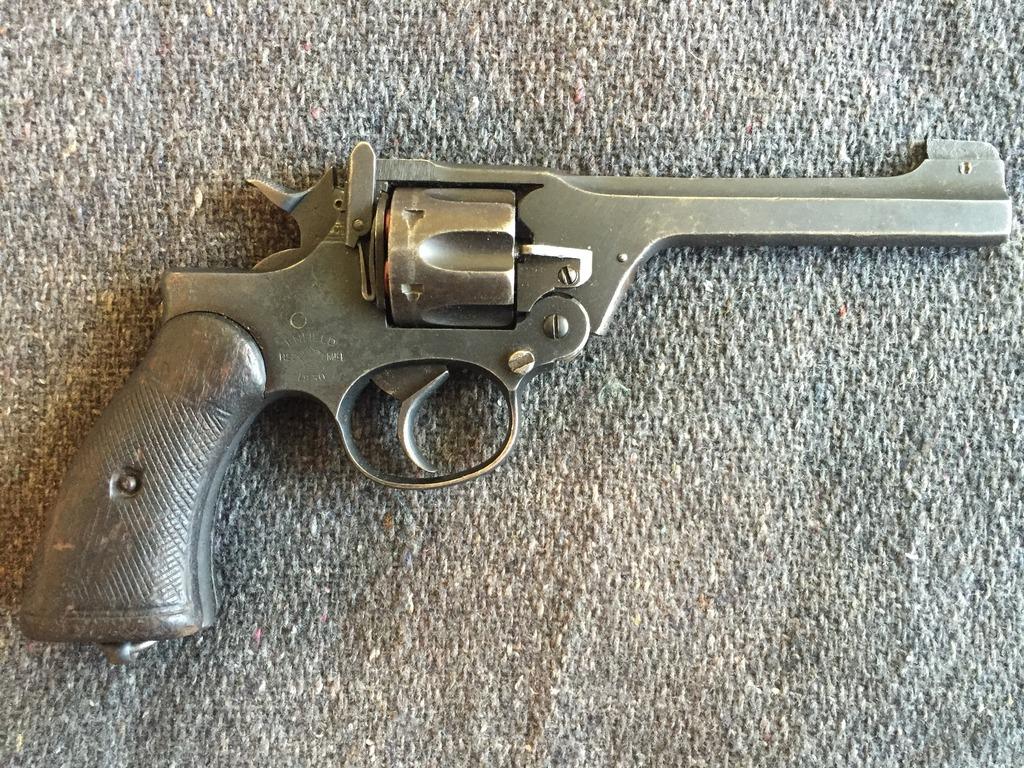-
Legacy Member

My new to me Enfield No 2 Mk 1
Just picked up this early Enfield revolver. Serial number 2621, dated 1930.
She's a rebuild. The cylinder has been re-serialed to match. And originally bore the serial number 5303. The barrel has only one serial number, but the stamping matches the renumbered cylinder. So I'm guessing it was a replacement barrel at the same time this cylinder was added, but was new and not cannibalized from another revolver. Sounds reasonable?
Fair bit of pitting under the old wooden grips. Otherwise pretty good. Definitely a well worn old girl though.
Can someone tell me how to remove the cylinder for cleaning?

Information
 |
Warning: This is a relatively older thread
This discussion is older than 360 days. Some information contained in it may no longer be current. |
|
-
The Following 2 Members Say Thank You to Baal For This Useful Post:
-
06-02-2015 02:57 PM
# ADS
Friends and Sponsors

-
Legacy Member

Here you go
1. Unscrew cam lever fixing screw. Push barrel catch to open pistol and remove the cylinder.
2. Unscrew the stock and side plate screws on the left side of the weapon ; and remove the stock and the side plate.
3. All parts are now exposed and further dismantling is not recommended except by a competent armourer, as springs and parts may be damaged unless properly handled.
( Courtesy W H B Smith - Small Arms Of The World, 1945 )
-
The Following 4 Members Say Thank You to Aussie48 For This Useful Post:
-
-
The Following 2 Members Say Thank You to Badger For This Useful Post:
-
There's a LOT of info opn these little pistols on this forum.
We were only permitted to replace barrels and cylinders at Base Workshop due to the nature of the hand fitting involver which included many, many gauges and tight tolerances. As Armourers and according to our bible, we were never allowed to re-use an old cylinder or barrel as has been done with yours because by definition, it will have been worn to have been removed from the original weapon.
Spare barrels and cylinders were VERY uncommon in my opinion (even at Base Workshops) and always carried the small letter S somewhere to indicate (reportedly) that certain dimensions that required accurate hand fitting were slightly oversize.
-
The Following 4 Members Say Thank You to Peter Laidler For This Useful Post:
-
Legacy Member

Been a while since I got this revolver. It's been sitting in the safe so far.
Peter I've been following your advice and have read back in this forum about 5 years back so far. And I have a copy of Stamps and Skennetons book in the mail to me now.
This is definitely a dogs breakfast. The cylinder has been force matched and renumbered as mentioned. And it wears a 1945 dated barrel which bears only the one serial number but in the same font as the renumbered cylinder. The bore is bright and the rifling is great.
The cylinder gap with the trigger pressed is 0.005". Timing appears correct and there's just a hint of wiggle in the cylinder when I jiggle it with my fingers with the trigger pressed.
The screw on the right hand side of the frame with the wide slot for a coin seems seized. I've been unable to budge it so far. Any suggestions on how to loosen it?
Last edited by Baal; 08-10-2015 at 02:18 PM.
-
-
That wide slot is in fact a coin slot and the screw has a very coarse thread. So just twist it hard and it'll go.......
The only 'wiggle' test you need to concern yourself with is with the trigger pressed, gun fired and hammer fully forward. NOW wiggle the cylinder. It should barely move. There was a 'pokering' test set for this but guess where the gauges usually stayed...........?
-
-
Legacy Member

Yep. Just a very small amount of wiggle when I do that. Only a couple thousandths movement. I read your old posts about the pokering gauges. 
I'll try twisting that coin slot harder.
Thanks
Last edited by Baal; 08-11-2015 at 12:06 AM.
-
-
Legacy Member

So I finally got to the range with this Enfield. Only test fired 6 rounds. All six rounds were in a 3 inch group at 8 yards fired unsupported in single action. But the 3rd and 5th rounds only lightly dented the primer in the first attempt. The 3rd round required 3 tries, and the 5th round required 2 tries.
-
-
Legacy Member

Back to this old girl again. So I've put 100 rounds of new manufacture Remington 38 S&W through it now. And had a dozen light hammer strikes which did not fire the round. These have been in at least 3 chambers, possibly more.
The brass measures 0.055" at the rim as per spec.
The firing pin protrusion is at the minimum spec of 0.040".
The gap between the cylinder and recoil plate is 0.082". I dunno if this is within spec or not. Can't find a reference for it in Skennerton 's book.
's book.
Does this sound like a weak main spring issue? Or is that gap too great? Other ideas?
I really like this old revolver and want her functioning properly.
Last edited by Baal; 04-05-2016 at 01:19 AM.
-
-
Legacy Member



Originally Posted by
Baal

The gap between the cylinder and recoil plate is 0.082".
My Enfield No.2 and Webley Mk.IV measure .062''.
-
 Information
Information














 PM
PM














